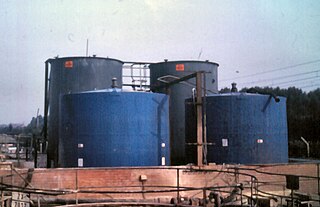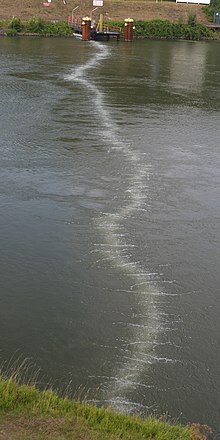Environmental issues
The release of compressed air in the water adds oxygen to the local environment. This may be particularly useful in areas that have become a dead zone due to eutrophication.
Air curtains may have another application. Dolphin and whale beaching has increased with the rise in ocean temperatures. On Thursday February 12th, 2017, a group of nearly 400 whales beached near Golden Bay on the tip of New Zealand’s South Island, following a similar incident earlier that week. The simplicity of an air curtain system, requiring only air compressors and perforated hoses, could allow for rapid deployment and create aerated zones of oxygenated seawater during a marine emergency.
Air curtains are also used to control the release of smoke particles into the environment. After a natural disaster, or during brush clearing activities, debris is disposed of by incineration in either a ceramic or earth pit containment. Similar to an air curtain to separate indoor air from outdoor air, for instance in restaurants and walk-in refrigerators, a powerful air curtain can defeat the chimney effect of the incineration process to eliminate any smoke from a brush incinerator. The air curtain acts as a lid on the process, and forces the smoke back into the fuel bed for a cleaner burn.
Filtration is a physical process that separates solid matter and fluid from a mixture.

An oil spill is the release of a liquid petroleum hydrocarbon into the environment, especially the marine ecosystem, due to human activity, and is a form of pollution. The term is usually given to marine oil spills, where oil is released into the ocean or coastal waters, but spills may also occur on land. Oil spills may be due to releases of crude oil from tankers, offshore platforms, drilling rigs and wells, as well as spills of refined petroleum products and their by-products, heavier fuels used by large ships such as bunker fuel, or the spill of any oily refuse or waste oil.
An air-start system is a power source used to provide the initial rotation to start large diesel engines and gas turbines.
Compressed air is air kept under a pressure that is greater than atmospheric pressure. Compressed air is an important medium for transfer of energy in industrial processes, and is used for power tools such as air hammers, drills, wrenches, and others, as well as to atomize paint, to operate air cylinders for automation, and can also be used to propel vehicles. Brakes applied by compressed air made large railway trains safer and more efficient to operate. Compressed air brakes are also found on large highway vehicles.

A safety curtain is a passive fire protection feature used in large proscenium theatres. It is usually a heavy fabric curtain located immediately behind the proscenium arch. Asbestos-based materials were originally used to manufacture the curtain, before the dangers of asbestos were widely known. The safety curtain is sometimes referred to as an iron curtain in British theatres, regardless of the actual construction material.
A gas lift or bubble pump is a type of pump that can raise fluid between elevations by introducing gas bubbles into a vertical outlet tube; as the bubbles rise within the tube they cause a drop in the hydrostatic pressure behind them, causing the fluid to be pulled up. Gas lifts are commonly used as artificial lifts for water or oil, using compressed air or water vapor.
Passive nuclear safety is a design approach for safety features, implemented in a nuclear reactor, that does not require any active intervention on the part of the operator or electrical/electronic feedback in order to bring the reactor to a safe shutdown state, in the event of a particular type of emergency. Such design features tend to rely on the engineering of components such that their predicted behaviour would slow down, rather than accelerate the deterioration of the reactor state; they typically take advantage of natural forces or phenomena such as gravity, buoyancy, pressure differences, conduction or natural heat convection to accomplish safety functions without requiring an active power source. Many older common reactor designs use passive safety systems to a limited extent, rather, relying on active safety systems such as diesel powered motors. Some newer reactor designs feature more passive systems; the motivation being that they are highly reliable and reduce the cost associated with the installation and maintenance of systems that would otherwise require multiple trains of equipment and redundant safety class power supplies in order to achieve the same level of reliability. However, weak driving forces that power many passive safety features can pose significant challenges to effectiveness of a passive system, particularly in the short term following an accident.
Saltwater intrusion is the movement of saline water into freshwater aquifers, which can lead to groundwater quality degradation, including drinking water sources, and other consequences. Saltwater intrusion can naturally occur in coastal aquifers, owing to the hydraulic connection between groundwater and seawater. Because saline water has a higher mineral content than freshwater, it is denser and has a higher water pressure. As a result, saltwater can push inland beneath the freshwater. In other topologies, submarine groundwater discharge can push fresh water into saltwater.

Prairie-Masker is a radiated noise reduction system fitted to some western warships, including the Oliver Hazard Perry-class frigates, Spruance and Arleigh Burke-class destroyers, and the Ticonderoga-class cruisers of the US Navy. The system was also installed during the 1960s on a limited number of post WWII Guppy III modified, and later diesel submarines.

Bunding, also called a bund wall, is a constructed retaining wall around storage "where potentially polluting substances are handled, processed or stored, for the purposes of containing any unintended escape of material from that area until such time as a remedial action can be taken."

A potato cannon is a pipe-based cannon that uses air pressure (pneumatic), or combustion of a flammable gas, to launch projectiles at high speeds. They are built to fire chunks of potato, as a hobby, or to fire other sorts of projectiles, for practical use. Projectiles or failing guns can be dangerous and result in life-threatening injuries, including cranial fractures, enucleation, and blindness if a person is hit.

A bubble curtain is a system that produces bubbles in a deliberate arrangement in water. It is also called pneumatic barrier. The technique is based on bubbles of air (gas) being let out under the water surface, commonly on the bottom. When the bubbles rise they act as a barrier, a curtain, breaking the propagation of waves or the spreading of particles and other contaminants.
Spill containment is where spills of chemicals, oils, sewage etc. are contained within a barrier or drainage system rather than being absorbed at the surface. One method is to use an inflatable stopper or pneumatic bladder which is inserted into the outflow of a drainage system to create a containment vessel. In the event of a spill the stopper bladder is inflated to block the drain/s and to prevent the spilled agent from entering the ground water, stream or river.
A hydraulic compressor is a type of compressor that is designed to convert hydraulic power to pneumatic power. It is used across various industries to improve the efficiency of certain types of machinery. Hydraulic compressors have a hydraulic pump to push air through a pipe, which forces a motor to spin. The motor powers the internal air compressor, releasing air in a chamber as a result. Compressors became more popularized in 1799 when Englishman George Medhurst invented a motorized air compressor as a means for propulsion. They have technologically advanced to the point where they can achieve greater force and precision than humans.
The following is a timeline of the Deepwater Horizon oil spill. It was a massive oil spill in the Gulf of Mexico, the largest offshore spill in U.S. history. It was a result of the well blowout that began with the Deepwater Horizon drilling rig explosion on April 20, 2010.

Offshore oil spill prevention and response is the study and practice of reducing the number of offshore incidents that release oil or hazardous substances into the environment and limiting the amount released during those incidents.
Efforts to stem the Deepwater Horizon oil spill were ongoing from the time that the Deepwater Horizon exploded on April 20, 2010 until the well was sealed by a cap on July 15, 2010. Various species of dolphins and other mammals, birds, and the endangered sea turtles have been killed either directly or indirectly by the oil spill. The Deepwater Horizon spill has surpassed in volume the 1989 Exxon Valdez oil spill as the largest ever to originate in U.S.-controlled waters; it is comparable to the 1979 Ixtoc I oil spill in total volume released.

Johan van Veen was a Dutch hydraulic engineer. He is considered the father of the Delta Works.

The Volkerakdam or Volkerakwerken is the name given to a group of hydraulic engineering structures located between Goeree-Overflakkee and North Brabant in The Netherlands. The works are not a single dam, but are composed of three distinct structures: a dam between Goeree-Overflakkee and Hellegatsplein, a series of locks from Hellegatsplein to North Brabant, and a bridge from Hellegatsplein to Hoekse Waard. The works cross three separate bodies of water: the Haringvliet, Hollands Diep and Volkerak. The works together comprise the fifth project of the Delta Works.










